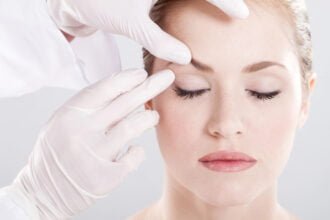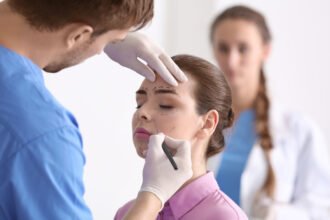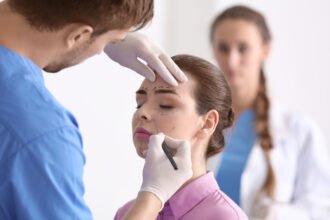For those who are looking into nasal plastic surgery options, a nonsurgical rhinoplasty may be the route to consider. This procedure can be especially beneficial for those considering a surgical rhinoplasty but want a non-permanent preview of the results before going through the surgery. Even if you have had a surgical rhinoplasty, filler injections can help make minor revisions to previous work.
While looking into your options, you may wonder what a nonsurgical rhinoplasty is, what the procedure entails, and how to prepare for the process. Below is a breakdown of the procedure, how to prepare for it, and what to expect the day you walk into the surgeon’s office.
What is It?
A nonsurgical rhinoplasty is when a plastic surgeon injects dermal fillers into a patient’s nose to change the shape. There are several facts about the procedure itself that prospective patients should know, as well as what a nonsurgical rhinoplasty can and cannot do.
About Nonsurgical Rhinoplasty
The procedure itself can involve different types of dermal fillers, the most common being hyaluronic acid fillers, such as Restylane or Juvederm. However, both can be dissolved if they are injected into the wrong area. An alternative is a calcium hydroxyapatite dermal filler called Radiesse, which is long-lasting but cannot be as easily reversed.
Though the two dermal fillers have different chemical compositions, the basic facts about the surgery apply to both types. Nonsurgical rhinoplasties are quick, usually taking roughly fifteen minutes, and are much cheaper than rhinoplasties that require surgical cutting.
Results from nonsurgical rhinoplasties are immediate but temporary. The nurse will use topical anesthesia, usually a numbing cream or ointment so that, when injections are being performed, the patient is less likely to experience any pain above a light pinching sensation.
Like most types of plastic surgery, nonsurgical rhinoplasties come at a reasonable price. The cost depends on the type and amount of dermal filler used, but nonsurgical rhinoplasties are typically around $1,000 out-of-pocket, since insurance rarely covers this procedure. Because the procedure is temporary, it will need to be repeated once every one or two years to keep the effect.
Patients Who Should Avoid This Procedure
There are medical conditions that can prevent a patient from getting nonsurgical nasal surgery. For example, those with autoimmune diseases or bleeding disorders are unable to get the surgery. This list also includes those who are allergic to the filler ingredients, or patients with infections, swelling, redness, or precancerous/cancerous lesions near the nose. The procedure is also barred for patients that are pregnant, breastfeeding, or diagnosed with body dysmorphic disorder.
Other medical conditions may require a waiting period or treatment plan in order to get a nonsurgical rhinoplasty. A person on blood-thinning medications or supplements may need to go off their drugs for a period of time to allow for the procedure. Patients with facial skin conditions like cold sores, acne, or rosacea may need to wait for a period of time until their condition is less severe or adequately treated in order to get a nonsurgical rhinoplasty.
Even without these medical conditions, there are slight risks involved in getting a nonsurgical rhinoplasty. The most common symptom is redness, swelling, tenderness, or bruising around the injection site, though they usually disappear within one or two weeks of the procedure. Other risks are more dangerous, such as the formation of hematoma (blood pooling outside of the blood vessel) or granulomas (small clumps of white blood cells).
Though unlikely, the filler can also be accidentally injected into a blood vessel in the nose. This blockage may stop blood from flowing through the nose, causing necrosis or tissue death. If the blockage affects the artery supplying blood to the retina, vision loss can also occur.
What the Procedure Can and Cannot Do
There are several cosmetic improvements that a nonsurgical rhinoplasty can accomplish. The procedure can fix small bumps, depressions, dents or grooves, and a low or flat bridge. If the patient’s nose has general asymmetry or crookedness, dermal fillers can help fix that. Other cosmetic flaws such as a drooping nasal tip, a saddle-nose profile, or a dip in the bridge of the nose can be fixed with this procedure.
However, there are also several cosmetic improvements that a nonsurgical rhinoplasty cannot fix. For example, if a patient has breathing problems or an internal defect like a deviated septum, this procedure will not fix that issue. It also cannot reduce a large nose, bridge, or bump.
The goal of a nonsurgical rhinoplasty, just as any other treatment, is to make an improvement. There is no guarantee of perfection with any procedure, surgical or nonsurgical.
How to Prepare
To prepare for a nonsurgical rhinoplasty, a patient needs to consult their plastic surgeon before the procedure. They might need to make a series of preoperative lifestyle changes before going to the surgeon’s office.
Consulting Other Medical Professionals
Before the procedure, a patient may need to meet with their primary care physician about medications that need to be halted pre-procedure. For example, non-steroidal anti-inflammatory drugs (NSAIDs) or vitamin/herbal products that thin your blood may need to be stopped a week before the procedure. If a patient uses Retin-A, it cannot be applied the two days preceding the session.
A patient may also be given medications to take to prepare for their nonsurgical rhinoplasty. For example, patients with a history of cold sores may be prescribed an antiviral medication to prevent any sores forming before the procedure.
Before going to the plastic surgeon’s office, you may also need to consult a psychiatrist. This is to ensure a patient does not have body dysmorphic disorder, which can be damaging for those with that condition.
Going to the Plastic Surgeon
When talking with your plastic surgeon and surgical team, make sure they know every medication you take. This includes prescriptions, over-the-counter medications, herbal products, dietary supplements, vitamins, and recreational drugs.
Some may wonder if bloodwork for an anesthesia clearance is required for this procedure. Because the anesthetic used is a topical cream and not general anesthesia, bloodwork is rarely needed.
Before your appointment, the plastic surgeon will likely inform you about some pre-operation lifestyle changes. Two weeks pre-appointment, a patient should not get any vaccines or undergo any medical, dental, or cosmetic procedures. Once the consultation is complete, the doctor will inform you of the location for your procedure which is usually the office where you had the consultation.
What to Expect
The day of your nonsurgical rhinoplasty may be nerve-racking, especially if it is your first time going through such a procedure. Here is a breakdown of every event that happens before, during, and after the procedure.
Before Nonsurgical Rhinoplasty
When you arrive at the plastic surgeon’s office, a nurse will take you to the room where the procedure will take place. There, the nurse will review your listed medications and record your vitals. When the surgeon comes in, they will review the procedure, discuss the expected outcome, list potential risks, and then ask you to sign a consent form.
After the form has been signed, the doctor will use a special pen to mark places on your face that act as guiding points, telling the surgeon where the injection sites should be. A photograph may also be taken as a “before” picture.
Once that is done, the nurse will disinfect the skin and apply numbing cream or ointment. This topical anesthetic usually takes 20 minutes to take effect, so you will usually sit comfortably in the chair until the nose goes numb.
During the Procedure
The procedure is quick, only taking 15 minutes to complete. The doctor will inject specific locations depending on what the patient wants to be done to their nose. If the patient wants to improve the angle between their nose and forehead, the doctor will inject the dermal filler above or below the bump.
When injecting, the patient may feel a slight pinching sensation or pressure around their nose. Between injections, the doctor may massage the nose to help get the desired shape. Once this is complete, the doctor will give the patient an ice pack to help with any immediate swelling and discomfort.
After Nonsurgical Rhinoplasty
After the procedure, the surgeon may discuss any questions and concerns you may have. Afterwards, you will be all set to drive home. There may be some mild numbness or tenderness over the next two days following the procedure and some bruising may occur. However, all bruises and redness should heal within two weeks at the latest.
Recovery
You should avoid vigorous activity or touching the injection site for 24 hours post-procedure in order to recover properly. To help with swelling, apply ice packs for 10-20 minutes every hour. If you are experiencing mild discomfort, take over-the-counter Tylenol according to the instructions on the label.
There are some things you should avoid post-procedure, such as sun, alcohol, or salty foods. If the bridge of the nose was injected, avoid wearing goggles, sunglasses, or eyeglasses for at least two weeks. Wearing makeup and showering can be done within 24 hours of the procedure but check with your physician about their recommendations, as that waiting period can differ depending on the specific procedure.
Alongside things to avoid, there are also symptoms you should be aware of after the procedure. If you are experiencing severe nose pain, excess swelling or bruising, itching sensations, and blister or scab formation, call your surgeon to ask about your symptoms. If the symptom becomes visual, you should go to the emergency room.
After the recovery period, you will likely return to your surgeon’s office to review the results, monitor complications, and possibly tweak the nose with more filler. A picture will also be taken to compare with the photo taken before the operation.
Nonsurgical rhinoplasties may need to be repeated every one or two years to maintain the patient’s desired nose shape. If there is a severe complication following the procedure, such as skin necrosis, additional surgery may be needed.









